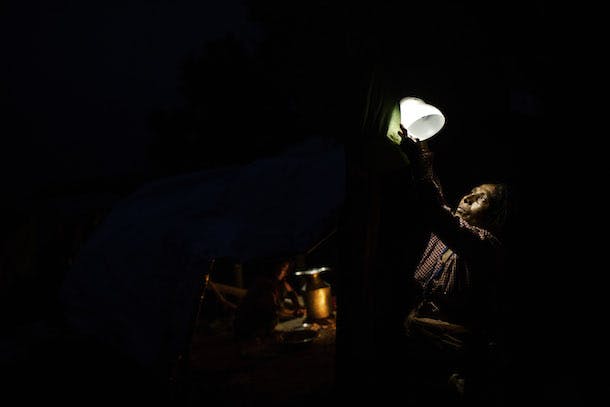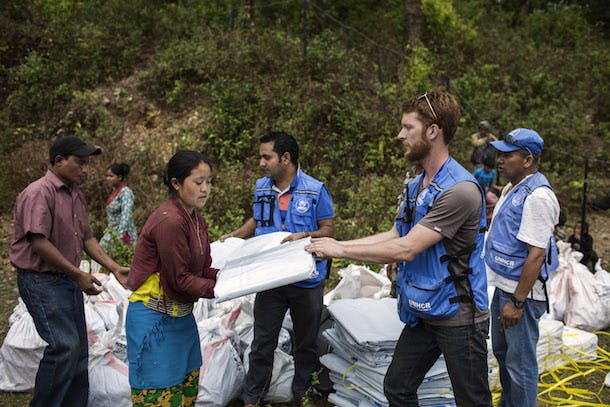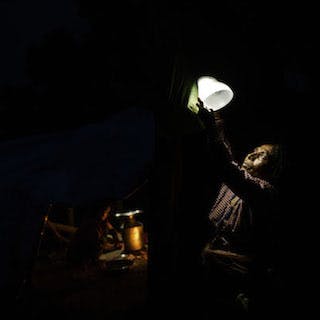
As emergency humanitarian aid efforts in Nepal enter their second month following two powerful earthquakes, an estimated 2.8 million people are living in the open and are in need of assistance and protection.
The Government of Nepal estimates that over 200,000 houses have been destroyed and another 200,000 badly damaged. Shelter is an overwhelming and urgent need. Sleeping outside can have a devastating effect on health – particularly for the very young, the very old, and the more than 14,000 people who were injured. Most have no access to electricity or water, and it is unclear when infrastructure and utilities will be significantly restored, so interim solutions are required.
The UN Refugee Agency (UNHCR) has 107 staff on the ground who are working with partners around the clock to provide assistance for those affected.

You can support UNHCR’s work: $50 can help fly in one plastic sheet to protect and shelter a family, and $65 can help fly in and deliver a solar lantern. You can make a donation at: http://donate.unhcr.org/international/nepal.
In an interview via phone from Geneva, Joung-ah Ghedini-Williams, UNHCR’s Emergency Response Coordinator, discussed the agency’s response to help the displaced. Here are three things to know about UNHCR’s work in Nepal:
1. UNHCR’s immediate and comprehensive response covers shelter and energy needs.
UNHCR’s relief efforts in Nepal have focused on shelter and lighting. Within 24 hours, 11,000 plastic sheets, 4,000 solar lamps, and other basic supplies were delivered to help meet the most urgent needs of survivors.
Families explained that they were using the wood beams and bricks from their damaged and destroyed houses to rebuild new permanent houses and using the plastic sheeting as the interim roofs until they could find more long-term roofing materials. They also could use the plastic sheeting for other needs such as covering windows and latrines.
So far, UNHCR has delivered 24,000 plastic sheets and 5,500 solar lanterns. UNHCR’s quick response resulted in relief items being immediately loaded and delivered from its warehouse in Damak, in the east of the country, where UNHCR had already been accommodating refugees from Tibet and Bhutan.
2. Energy is life-saving for women, children, and elderly in humanitarian emergencies.
Most emergency humanitarian relief looks at basic life-saving aspects like food and shelter, but UNHCR also looks at energy in terms of its protection mandate. For families that have been separated, and women in particular, solar lighting makes a critical difference. The evenings have been cold, and there have been days when night temperatures dropped to single digits; with elderly, young children, and breast-fed babies among the displaced, energy sources help provide much needed heat for warmth and cooking in safety.
For UNHCR’s own operations, 20 solar generators have been deployed because in some of the regions power has been down for days and there are no avenues for communications. Energy sources have also been critical for UNHCR communications and for the smooth provision of aid. In situations such as Nepal where infrastructure has been extensively damaged and it will take time to rebuild, having reliable energy sources such as solar is central to providing emergency relief.
3. Coordination is key to long-term relief.
In emergency relief situations, immediate needs are very clear and people mobilize quickly to help. For example, the airports in Nepal were overwhelmed, everybody wanted to bring in shelter supplies, and there was little effort towards road clearance. Coordination among various agencies is key to resolving such situations.
UNHCR has been working quickly and closely with the government from the start. UNHCR efforts to provide temporary shelters has focused on coordination for long-term relief. Whether it is Syria or Nepal, trying to create assistance plans that address the full extent of the problem in a cohesive way is important.
In Nepal, people want sheltering solutions that lead to a longer-term, permanent solution that address their displacement. Long-term housing solutions have been raised as a priority by affected communities and plastic sheeting was communicated as the best solution in rapid needs assessments conducted by UNHCR. Coordination with local communities and other actors, including governments and non-profits, ensures that UNHCR’s interventions contribute to long-term solutions in Nepal.
(Photos: UNHCR/Diego Ibarra Sanchéz/May 2015)

